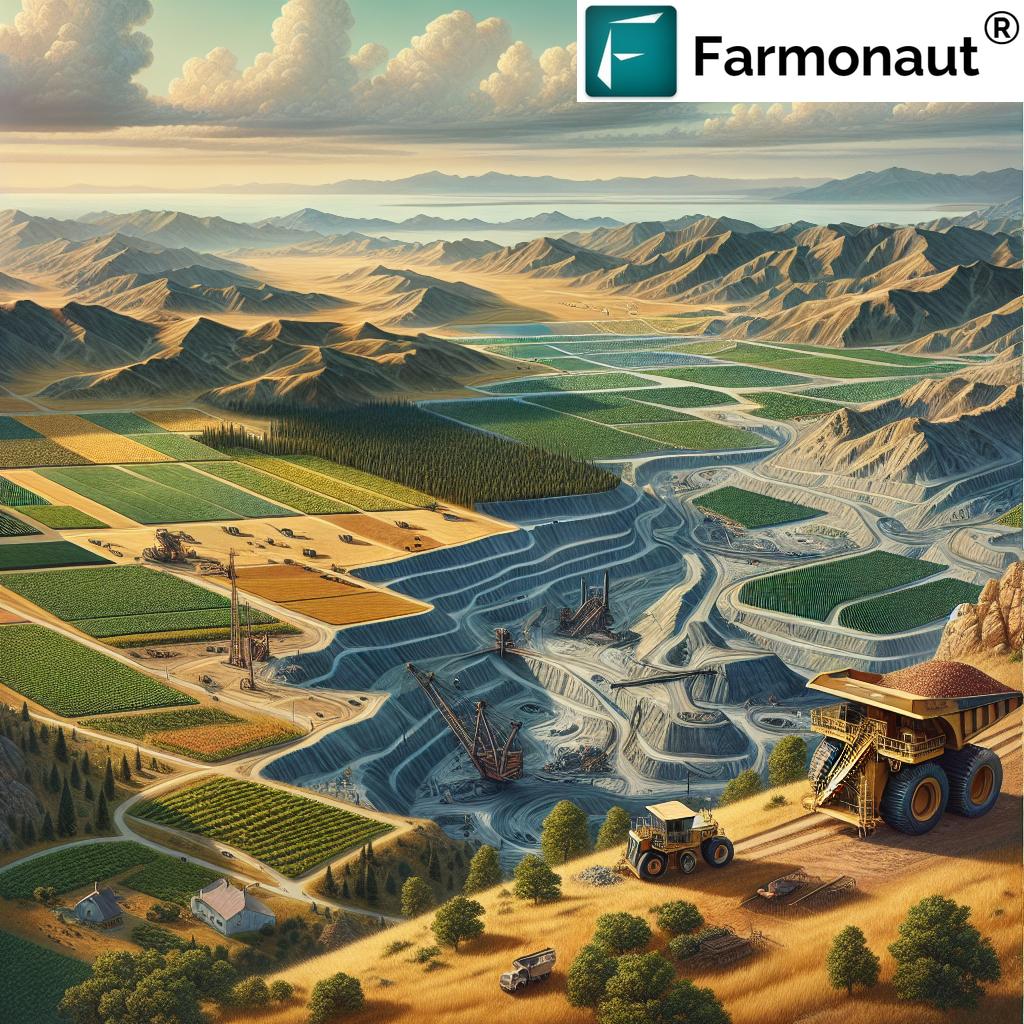Callery Pear, Pyrus calleryana: 7 Smart Strategies for 2026
“Callery pear can grow up to 40 feet tall, rapidly invading over 13% of surveyed U.S. forestry plots by 2025.”
Table of Contents
- Introduction: The Context of Callery Pear, Pyrus calleryana in 2026
- Botanical and Ecological Profile of Pyrus calleryana
- Ecological & Economic Impacts: Callery Pear as an Invasive Species
- Agricultural and Forestry Management Challenges
- 7 Smart Strategies for Callery Pear Management in 2026
- Strategy-Impact-Technology Comparison Table
- Advanced Technology & Remote Sensing for Early Detection and Control
- How Farmonaut Empowers Smart Forestry & Agriculture Management
- The Future Outlook: Trends in 2026 and Beyond
- Frequently Asked Questions (FAQ)
- Farmonaut Subscriptions & Pricing Table
Introduction: The Context of Callery Pear, Pyrus calleryana in 2026
The callery pear (pyrus calleryana), including the popular cultivar ‘Chanticleer’, has gained widespread attention in agriculture, forestry, and land management. Originally introduced from East Asia in the early 20th century, this ornamental tree was prized for its rapid growth, urban resilience, and beautiful displays of white spring blooms. Especially the Chanticleer variety is favored for its narrow columnar shape and prolific nature in many urban environments.
However, as we approach 2026, the callery pear has emerged as both a valuable plant and a serious invasive species. Its dual nature creates complex ramifications for ecosystem dynamics and influences critical land management decisions. This blog dives deep into its ecological, agricultural, and forestry impacts, exploring the latest remote sensing advancements, GIS-based management, and 7 actionable strategies to control its spread and restore native biodiversity.
“Remote sensing mapped Chanticleer pear spread across 120,000 acres, prompting 7 advanced control strategies for 2026 management.”
Botanical and Ecological Profile of Pyrus calleryana
The callery pear (Pyrus calleryana) is a deciduous tree commonly known for its adaptability and ornamental qualities. Native to East Asia, it was originally introduced to North America in the early 20th century to enhance urban and suburban landscapes.
Key Botanical Traits
- Growth Type: Deciduous, with a maximum height of 30-40 feet.
- Leaf: Glossy, oval, dark green; turns red, orange, or purple in fall.
- Blossoms: Prolific clusters of small, white blooms in early spring.
- Fruit: Small, round, green to brown pears, attractive to birds but inedible to humans.
- Habitat Adaptability: Thrives in a wide range of soil types, withstands drought, urban pollution, and poor soil quality—making it highly adaptable across diverse regions.
These resilient qualities contributed to its popularity in urban plantings, roadside landscaping, parks, and reforestation projects. The Chanticleer cultivar is particularly distinguished by its upright, columnar habit, narrow shape, and suitability for tight urban spaces.
Why the Callery Pear Became an Invasive Threat
Ironically, the very qualities that make pyrus calleryana so valuable in cultivation—rapid growth, resilience, prolific seed production—are what contribute to its invasive potential. Once established, it quickly spreads beyond cultivated areas to natural and semi-natural landscapes, forming dense thickets and outcompeting native vegetation.
- Seed Dispersal: Small fruits consumed and dispersed by birds far beyond initial plantings.
- Vegetative Regrowth: Capable of re-sprouting from stumps and roots after cutting, making mechanical removal challenging.
- Thorny Branches: Deters wildlife and complicates field operations.
From suburban borders to rural forestry plots in the eastern and midwestern United States, pyrus calleryana chanticleer now remains a significant ecological threat due to its dual nature and prolific spread.
Ecological & Economic Impacts: Callery Pear as an Invasive Species
The invasion of the callery pear in forestry, agricultural, and natural landscapes triggers a cascade of complex ecological and economic impacts that land managers, farmers, and policymakers are increasingly compelled to address as we approach 2026.
Alteration of Ecosystem Dynamics
- Biodiversity Loss: Dense thickets of callery pear reduce native species availability and prevent regeneration of indigenous trees and understory plants.
- Wildlife Habitat Disruption: Thorny branches limit movement and foraging for mammals and birds, while changes in food sources affect the local food web.
- Soil and Water Cycle Impact: Altered leaf litter and root systems change soil chemistry and hydrology; may reduce soil quality and disrupt water infiltration.
Rising Economic Costs for Land Managers
- Increased Management Costs: Manual and chemical control programs can be labor-intensive and expensive, especially when dealing with large areas or repeated resprouting.
- Reduced Productivity: In mixed-use landscapes, invasive callery pear stands may reduce land available for agriculture or timber, diminish crop yields, or complicate pasture access for livestock.
- Threat to Urban Infrastructure: Root systems can damage sidewalks, pavements, and utilities in urban environments.
These economic implications drive the pressing need for integrated management strategies—blending traditional mechanical removal and novel technology-driven monitoring solutions.
Agricultural and Forestry Management Challenges
Both forest managers and farmers face unique challenges controlling the callery pear invasive spread. Understanding these is vital for effective response:
- Prolific Seed Production: Even isolated trees can seed entire landscapes due to bird dispersal.
- Difficult Removal: Mechanical removal of mature trees is hindered by dense thorns, deep roots, and resprouting.
- Chemical Control: Targeted herbicide applications are required, yet repeated applications may be needed to ensure lasting effect.
- Prescribed Fire: Generally ineffective as pyrus calleryana is fire-resilient and can resprout rapidly afterward.
- Lack of Biological Control: No approved biocontrol agents as of 2026, though research continues.
Why Action in 2026 Remains Critical
As policies increasingly restrict the sale and planting of callery pear cultivars and urban forestry programs pivot toward native alternatives, land managers require technology-driven monitoring to detect early spread and act swiftly.
7 Smart Strategies for Callery Pear Management in 2026
A sustainable response to the callery pear, Pyrus calleryana, Pyrus calleryana chanticleer problem demands a blend of innovative, technical, and on-the-ground approaches. Here are seven smart strategies that are leading the way in 2026 to reduce invasive spread, restore native biodiversity, and control costs in forestry and agricultural management:
-
1. Early Detection via Remote Sensing & GIS Mapping
- Utilize satellite-derived NDVI and multispectral imagery to identify and map callery pear stands, capturing dense formations and single trees across large landscapes.
- GIS layering enables prioritization of high-risk sites and planning of targeted operations.
- Benefit: Enables early intervention, containment, and cost savings by addressing outbreaks before dense thickets form.
Discover our Large-Scale Farm Management Platform for remote sensing, crop, and tree monitoring.
-
2. Mechanical Removal with Precision Tools
- Mechanical cutting, uprooting, and specialized forestry mulchers remove established stands.
- Effective for dense infestations—should be combined with herbicide spot-treatments to reduce regrowth.
- Challenge: Labor-intensive; thorny branches and vegetative regrowth complicate mechanical fieldwork.
-
3. Targeted Herbicide Applications
- Application of systemic herbicides (cut-stump or basal bark treatment) prevents regrowth after mechanical removal.
- Drone-based herbicide application, guided by satellite & GIS data, increases targeting precision and limits non-target impact.
- Needs monitoring for follow-up treatments.
-
4. Limiting New Plantings & Nursery Restrictions
- Enforcement of local/statewide bans on sale, propagation, and planting of callery pear cultivars such as Chanticleer.
- Promotion of resilient native species for urban and roadside landscaping—reducing future invasive risk.
-
5. Ecological Restoration with Native Plants
- Replace removed stands with a diverse mix of native trees and shrubs to restore plant community structure and prevent reinvasion.
- Improves soil quality, wildlife habitat, and ecosystem functionality over time.
Explore carbon footprint monitoring for ecological restoration and sustainable replanting.
-
6. Stakeholder Education & Reporting Platforms
- Educational outreach for agricultural land managers and urban planners about the risks of callery pear.
- Integrate citizen science and real-time reporting apps for early detection—enabling faster management response.
- Farmonaut platform can help aggregate, visualize, and prioritize such reports.
-
7. Continuous Monitoring & Adaptive Management
- Ongoing, seasonally updated remote sensing and ground surveys to monitor effectiveness of strategies and regrowth dynamics.
- Adaptive management enables agile response to new outbreaks as patterns shift due to climate and land-use changes.
Leverage Farmonaut Satellite API for continuous, automated invasive plant mapping and reporting across large land portfolios.
Try with our API Developer Documentation.
Strategy-Impact-Technology Comparison Table
| Strategy Name | Description | Technology Employed | Estimated Effectiveness (%) | Estimated Cost | Impact Potential |
|---|---|---|---|---|---|
| Early Detection via Remote Sensing & GIS | Use multispectral imagery & mapping for early identification | Remote Sensing, GIS | 80–90% | Medium | Prevents new thicket formation, high containment |
| Mechanical Removal | Physical removal of trees, roots, and seedlings | Excavators, Forestry Tools | 60–75% | High | Best for dense infestations, needs follow-up |
| Targeted Herbicide Applications | Use of systemics post-mechanical removal | Drones, Spray Systems | 70–85% | Medium | Reduces regrowth, must monitor nearby flora |
| Nursery Restrictions | Ban propagation and sale of invasive pear | Regulation & Policy | 60–95% (Prevention) | Low | Long-term reduction of future infestations |
| Restoration with Native Plants | Planting native species post-removal | Ecological Restoration Tools | 50–85% (Over time) | Medium | Restores biodiversity, resilience |
| Education & Reporting | Stakeholder training and real-time citizen reporting | Mobile Apps, GIS Web Portals | Variable (Boosts other strategies) | Low | Speeds up detection & intervention |
| Continuous Monitoring & Adaptive Management | Ongoing surveillance and flexible operations | Satellite/Drone Monitoring, Analytics | 80–95% | Medium | Adaptive, long-term control and prevention |
Advanced Technology & Remote Sensing for Early Detection and Control
Remote sensing and satellite-based monitoring have changed the paradigm of tackling invasive species like callery pear. With evolving AI-driven analytics and affordable access to high-resolution data, land managers can:
- Identify new stands or outbreaks across vast landscapes before they form dense thickets.
- Track seasonal growth patterns and detect regrowth after mechanical/chemical control.
- Overlay NDVI & multispectral indices with field maps for precision targeting.
- Use real-time alerts for quick mitigation, especially in sensitive or high-risk plots.
By integrating GIS with satellite-based risk verification systems, government agencies, insurers, and landowners can also better assess the long-term economic impact and optimize resource allocation for pyrus calleryana chanticleer control.
How Farmonaut Empowers Smart Forestry & Agriculture Management
As a pioneer in satellite technology for forestry and agriculture, Farmonaut enables managers, agencies, and governments to adopt data-driven strategies to control and monitor the callery pear, pyrus calleryana invasion. Utilizing our tools, users gain access to:
- Real-time satellite monitoring of vegetation health and the spread of invasive trees.
- Jeevn AI advisory—offering tailored insights on crop, soil, and forest canopy conditions.
- Blockchain-based traceability solutions—track interventions and ensure transparency in land management decisions.
- Resource optimization & fleet management—supporting cost-effective large-scale operational planning for removals and follow-up planting. Explore our fleet management platform to modernize your logistics.
- Environmental impact tracking—quantifying the success of ecological restoration, reforestation, and emission reduction after invasive species removal.
Our affordable subscription-based services (see pricing table below) are available through web, Android, iOS, and API access, empowering everyone from individual farmers to landscape-scale managers.
The Future Outlook: Trends in 2026 and Beyond
The callery pear, pyrus calleryana, pyrus calleryana chanticleer will likely remain a significant subject within forestry, land management, and agriculture circles for years to come. Moving into 2026 and beyond, key trends include:
- Stronger Policy Measures: Expanding regulations limiting the sale and use of invasive cultivars in all landscaping projects.
- Technological Innovation: Advances in AI, satellite imagery, and blockchain aiding not just control but also rapid ecological restoration and carbon monitoring.
- Community Engagement: More robust stakeholder reporting and educational programs, integrating landowners and citizens as “eyes in the field.”
- Focus on Native Species Success: Long-term shift toward promoting native, resilient trees that outcompete invasive threats and support wildlife and climate resilience.
- Ecological & Economic Sustainability: Synergy between environmental protection and cost-efficient land use, where satellite-based monitoring helps track both ecological recovery and operational expenses.
Effective future management must integrate technology, policy, restoration, and real-time data—putting power in the hands of managers, agriculturalists, and foresters to preserve biodiversity with science-led confidence.
Frequently Asked Questions (FAQ)
What is the main threat of the callery pear, pyrus calleryana, in forestry and agriculture?
The callery pear forms dense thickets that outcompete native trees and plants, reducing biodiversity, impacting wildlife, and disrupting ecosystem and soil dynamics. Its resilience and prolific seed spread make control challenging and costly.
Why was the Chanticleer pear originally introduced?
The Chanticleer cultivar was introduced for its columnar growth, stunning white spring blooms, and tolerance of pollution, drought, and poor soils. Its adaptability made it highly popular for ornamental urban and roadside plantings.
Which strategy is most effective for controlling established callery pear stands?
A combination of mechanical removal followed by targeted herbicide applications is currently the most effective for eliminating dense thickets. This should be complemented with restoration planting of native species and ongoing remote monitoring.
How does remote sensing help with invasive species management?
Remote sensing, including satellite and drone imagery, helps identify new outbreaks, monitor effectiveness of interventions, and guides cost-effective control by providing real-time, large-scale, and seasonal vegetation data.
How can Farmonaut assist land managers or foresters?
Farmonaut delivers real-time satellite data, AI-generated advisory, blockchain traceability, and fleet/resource management. This enables smarter, technology-driven decisions—from early detection of callery pear to verification of control actions and logistics optimization. Explore our product traceability solutions for transparent reporting.
Farmonaut Subscriptions & Pricing
Choose an affordable, scalable Farmonaut plan to bring satellite-driven insights into every stage of your forestry, agriculture, or ecological management workflow.
Conclusion: Toward Resilient Land Management in 2026 and Beyond
The callery pear (pyrus calleryana) is emblematic of the challenges balancing ornamental value with ecological responsibility. As we move into 2026 and face mounting agricultural and forestry pressures, communities must leverage advanced technology, informed policy, and on-the-ground action to mitigate the impacts of this invasive species.
With smart monitoring platforms, cutting-edge analytics, and integrated strategies, preserving biodiversity and restoring ecosystem functionality is within our grasp. Explore Farmonaut’s large-scale management platform and join the next generation of proactive, resourceful land stewardship.












